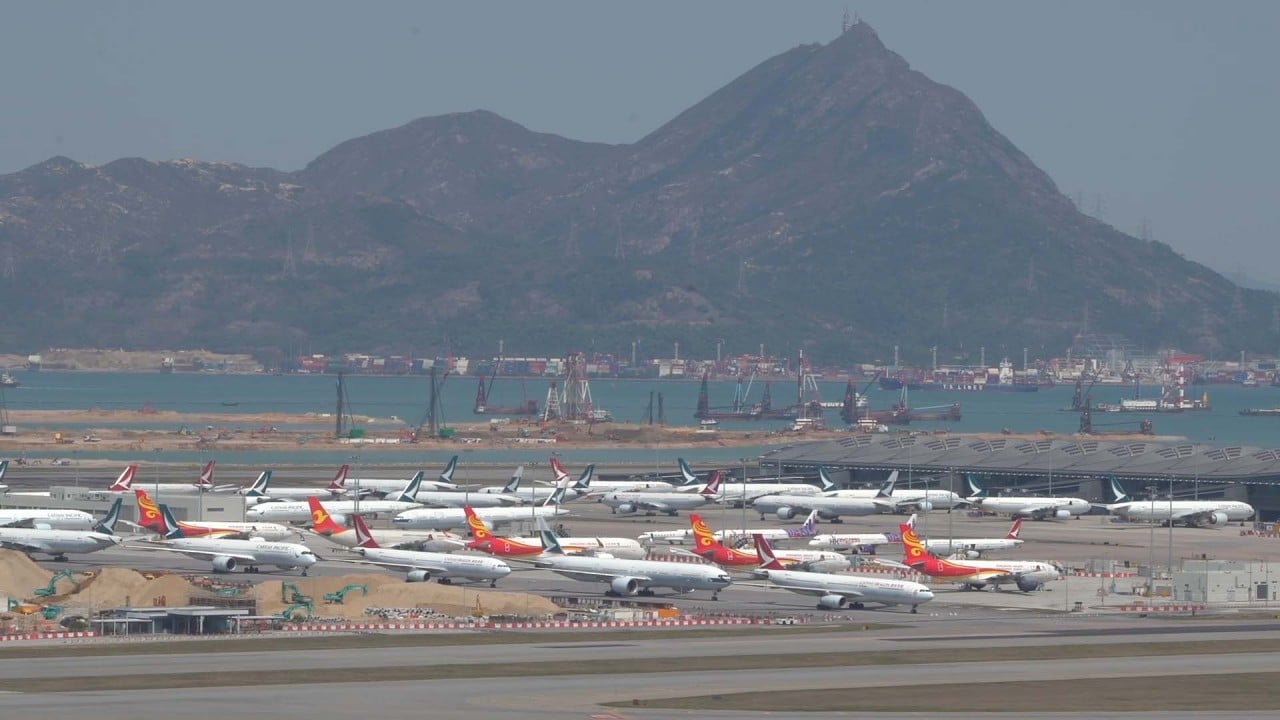
Hong Kong’s Cathay Pacific Airways posts loss of nearly HK$5 billion for first half of 2022, as firm warns city is ‘far behind’ other aviation hubs
- Smaller loss compared with last year attributed to rebound in passenger flights
- Cathay chairman Patrick Healy calls city’s strict travel restrictions on aircrews ‘single biggest impediment’ to company’s plans to operate more flights
Hong Kong’s Cathay Pacific Airways has announced a loss of HK$4.99 billion (US$636.8 million) for the first half of 2022, 33.9 per cent down from the same period last year amid a strong rebound in passenger flights.
The figure, which is smaller than the HK$7.56 billion loss recorded in the first six months of 2021, was released as the city’s flagship carrier on Wednesday warned that Hong Kong had fallen “far behind” other international aviation hubs.
Cathay chairman Patrick Healy said the city’s strict anti-epidemic travel measures for aircrews were the “single biggest impediment” to the company’s plans to operate more flights.
Even if the government opted to remove all Covid-related travel restrictions, Healy said, it would take “several months” to increase flight capacity, citing a crew retraining backlog that could not be addressed until quarantine rules were lifted.
He also called on the government to issue a “clear road map” on when all travel restrictions would be removed so the airline could plan ahead.
Cathay Pacific puts Hang Seng stocks to shame with US$3.1 billion rebound
Currently, Hong Kong-based aircrews for passenger flights are required to quarantine for three nights at a designated hotel upon arriving in the city. Locally-based cargo crews are exempt from the measure.
“While those restrictions remain in place, it is very difficult for us to accelerate and build back capacity that is going to be required to meet the increase in demand,” Healy said.
Hong Kong is set to reduce the hotel quarantine period from seven days to three from Friday, with inbound arrivals allowed to spend the remaining four days at home or in other accommodation with limited freedom of movement.

To meet the expected surge in demand for travel, Cathay said it would bring back aircraft parked overseas and hire 4,000 staff over the next 18 months to two years.
Cathay said it had 68 aircraft stored overseas, while about 30 were parked in Hong Kong.
“We brought back a number of aircraft in the first half of the year and we will continue to do that on a regular basis,” said chief operations and service delivery officer Greg Hughes, adding that the “speed and pace” of the move would depend on when travel restrictions were removed.
The airline announced in late July that it would bring back passenger planes parked in the desert surrounding the town of Alice Springs in Australia, where one-third of its fleet was previously sitting idle.
Healy also acknowledged an imbalance in supply and demand had led to a spike in airfares, which he said would only come down once Cathay was able to increase its flight capacity.
The city’s flag carrier was among businesses hard hit by tough coronavirus control measures, especially for most of the first six months of the year when the fifth Covid-19 wave ran rampant.
But Cathay attributed the rebound during the first half of 2022 to a strong passenger flight business, which increased 178.9 per cent from the same period last year to HK$2.08 billion.
The airline carried 335,000 passengers during the first six months of the year, up 113.4 per cent from the same period in 2021.
How Cathay Pacific is readying for take-off in the post-pandemic era
The company also reported a 17 per cent increase in revenue to HK$18.55 billion, compared with HK$15.85 billion in the same period last year, while costs decreased slightly.
Cargo flights continued to be the airline’s breadwinner, generating HK$13.8 billion in revenue in the first half, an 8.9 per cent jump year on year.
The cargo load factor – an indicator of capacity filled – was 75.8 per cent compared with 81.4 per cent previously.
Meanwhile, the airline’s cash flow turned positive toward the end of the first six months, with financial results expected to improve in the second half of the year.
Cathay said it aimed to operate at 25 per cent of pre-pandemic capacity for passenger flights by December, up from the 11 per cent reported in June.
The airline added that it would seek to reach 65 per cent of pre-pandemic levels for cargo capacity by the end of 2022, while further increases for both services would only be possible once travel restrictions were lifted for Hong Kong-based aircrews.

Shukor Yusof, founder of aviation advisory firm Endau Analytics, said the airline had showed resilience in preserving its finances despite the first-half loss, calling the decision to raise its passenger capacity to just 25 per cent “justified.”
“Long-term, Cathay Pacific will do better than its rivals as it staggers its reopening,” he said.
In comparison, Singapore Airlines reported a profit of S$370 million (US$268 million) during the first quarter of the financial year starting in April and flew at 64 per cent of its pre-pandemic capacity in June, with the company aiming to reach about 81 per cent by December.
With no domestic travel market, Cathay and Singapore Airlines are wholly reliant on international travel and open borders.
Cathay Pacific expecting smaller losses in first half of 2022
The Cathay Pacific Group had HK$26.7 billion in liquidity as of the end of June 30, compared with HK$28.6 billion at the end of 2020.
The government initiated a bailout of the airline in 2020, providing a cash injection of HK$39 billion over the course of the pandemic in exchange for a 6.5 per cent stake in the company.
Cathay shares traded eight HK cents higher, or 0.94 per cent, at HK$8.60 on Wednesday.


